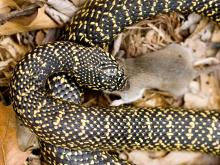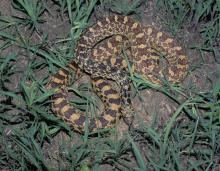Reptiles and Amphibians
Media

Species Types
Scientific Name
Lampropeltis holbrooki
Description
The speckled kingsnake is generally black, but a white or yellow spot in the center of most of the scales makes it look speckled. The belly is yellowish with some irregular black markings. A harmless, beneficial snake found nearly statewide.
Media

Species Types
Scientific Name
Pantherophis ramspotti
Description
The western foxsnake is a moderately large snake with distinct brown blotches. In Missouri, it is rare and found only in our far northwestern counties.
Species Types
Scientific Name
Pantherophis vulpinus
Description
The eastern foxsnake is extremely similar to the western foxsnake and is mainly identified by its different geographic distribution: in Missouri, this rare species is found only in a few counties along the Mississippi River floodplain north from St. Louis.
Media

Species Types
Scientific Name
Pituophis catenifer sayi
Description
Missouri's largest snake, the bullsnake may hiss loudly and vibrate its tail when alarmed, but it is nonvenomous. This species is extremely valuable in controlling destructive rodents.
See Also
About Reptiles and Amphibians in Missouri
Missouri’s herptiles comprise 43 amphibians and 75 reptiles. Amphibians, including salamanders, toads, and frogs, are vertebrate animals that spend at least part of their life cycle in water. They usually have moist skin, lack scales or claws, and are ectothermal (cold-blooded), so they do not produce their own body heat the way birds and mammals do. Reptiles, including turtles, lizards, and snakes, are also vertebrates, and most are ectothermal, but unlike amphibians, reptiles have dry skin with scales, the ones with legs have claws, and they do not have to live part of their lives in water.





















